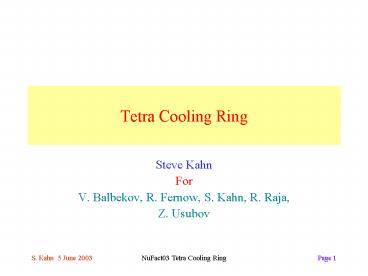Tetra Cooling Ring - PowerPoint PPT Presentation
Title:
Tetra Cooling Ring
Description:
V. Balbekov et al., Muon Ring Cooler for the Mucool Experiment, Proc PAC ... out a step function to a tanh or Enge function would solve this, but this has to ... – PowerPoint PPT presentation
Number of Views:16
Avg rating:3.0/5.0
Title: Tetra Cooling Ring
1
Tetra Cooling Ring
- Steve Kahn
- For
- V. Balbekov, R. Fernow, S. Kahn, R. Raja,
- Z. Usubov
2
Tetra Ring Parameters
Parameter Value
Circumference 36.954754 m
Kinetic Energy at Bends 0.250 GeV
Dipole Bending Field 1.453 T
Normalized Gradient Index 0.5
Maximum Long Solenoid Field 5.155 T
RF Frequency 205.69 MHz
Accelerating Gradient 15 MeV/m
LH2 Absorber Length 1.2 m
LiH Wedge Absorber 14 cm
3
Tetra Ring Simulations
- Original concept for this ring comes from V.
Balbekov. - Originally simulated in Valeris program.
- Documented
- V. Balbekov et al., Muon Ring Cooler for the
Mucool Experiment, Proc PAC 2001 Conf., p. 3867. - Updated in MUCnote 249 (2002).
- GEANT simulation of Tetra Ring.
- Worked on by Z. Usubov, R. Raja, and myself.
- ICOOL simulation of the Balbekov Ring.
- MUCnote 258.
4
Hardedge Model
- Wedge Dipole
- Combined function
- Index 1/2
- ?52 cm defines reference
- radius
- Step function s dependence.
- No dependence inside
- Zero outside
- Solenoids
- Effect of fringe field is approximated by
transverse impulse proportional to radial
position.
5
Coil configuration to represent mirror plate
boundary condition in ICOOL
Long Solenoid Arrangement
Boundary Condition Coils
Actual Hardedge Coils
Boundary Condition Coils
Short Solenoid Arrangement
-
-
-
Actual Hardedge Coils
Boundary Condition Coils
Boundary Condition Coils
6
ICOOL Hardedge Emittances
7
Tracking in GEANT
- This figure shows a sample of 500 events tracked
in GEANT. - The beam is smallest in the LH2 absorber where
the field is largest. - The beam is the largest in the field flip short
solenoid. - Muons are most likely to be lost in the vicinity
of the bend magnets.
8
Emittances from GEANT
6D Emittance
Transmission
4D Emittance
9
Toward a Realistic Muon Cooling Ring
- The hardedge field description of this cooling
ring violates Maxwells equations. - It is likely that smoothing out a step function
to a tanh or Enge function would solve this, but
this has to be demonstrated. - There is no free space in the lattice.
- This space would be necessary for flux returns
for the solenoids and field clamps for the dipole
magnet. - Flux returns and field clamps are necessary to
separate the function of the different lattice
elements. - Difficult engineering issues like how to inject
(eject) beam into (out of) this ring. - These kind of issues will be ignored at this
point.
10
Saturation in Dipole Magnet
- Figure shows the permeability for the vertical
midplane of the magnet. - ?lt10 on inner edge of the aperture.
11
By Off Vertical Symmetry Plane
Index Calculated on Difference Planes
12
Dipole Field along Reference Path
Figure 4 Field components for a path displaced
10 cm vertically from the reference path
Figure 3 By along central reference path.
13
Field and Geometry of the Long Solenoid
14
Field and Geometry of the Short Solenoid
- Figure at left shows Bs for cases
- Mirror plate boundary condition
- Partial mirror plate with 18 cm aperture
- No mirror plate. Full 29 cm aperture
15
Comparison of Realistic to Hardedge Field
16
Inserting a Gap into the Lattice
- Part of the difficulty with the Tetra ring is
that there is no extra space in the lattice for
flux return, field clamps, etc. - We have studied what is necessary to add a gap
between the end of the solenoids and the dipole
magnet
17
Inserting a Gap
- The extra focusing coils are placed symmetrically
at the ends of the solenoids into the lattice to
compensate and to match into the bending dipoles. - The requirements on the focusing coils are
- They retain the focusing of the solenoid, ie
is unchanged. - The value of Bs at the absorber remain unchanged.
- These requirements uniquely specifies the
focusing and other solenoid currents. - The RF frequency must be changed to account for
the additional length. - The harmonic number is not changed.
- The wedge angle in the field flip solenoid should
be adjusted for the focusing coil and other
solenoid current changes.
18
Field Flip Solenoid Field with Extra Focusing Coil
Original Coil Configuration
Adjusted with extra focusing coil
- Difference of 5º phase between these two
configurations. This is not corrected for.
19
Effect of Placing a Gap Between the Dipole Magnet
and the Solenoids
- Curves show transmission, ?tr, ?L vs. extra
focusing coil current. - Cases shown are for 5cm, 10 cm, and 15 cm gaps.
- PL is held constant and no decays in this
comparison.
20
Effect of Placing a Gap Using the Whole Momentum
Range
- Gaussian distribution for PL with ?P18 MeV/c.
- Plots show T, ?tr, ?L vs. focusing coil current.
- Transmission drops with increasing gap
21
A More Realistic Description of the Solenoids in
ICOOL
- As a step toward a more Maxwellian description to
the solenoid fields was tried - Mirror plate boundary conditions are removed in
solenoid regions. - Fringe fields from solenoid sheets are
superimposed on the dipole region. - The solenoid fringe field along the reference
path is the axial field. This, of course, is not
correct. - The solenoid end kicks used to describe the
fringe fields are removed. - The wedge bend magnet is still the hardedge
model. - The following transparency shows the emittance
calculated in ICOOL for this scenario.
22
ICOOL Emittances with Real Solenoids
















![How To Find The Perfect Engagement Ring - Guide For You [PPT] PowerPoint PPT Presentation](https://s3.amazonaws.com/images.powershow.com/8950903.th0.jpg?_=201711240210)














